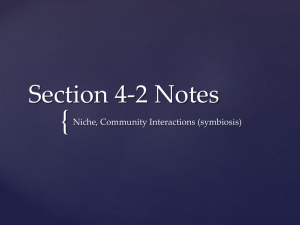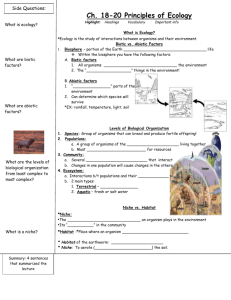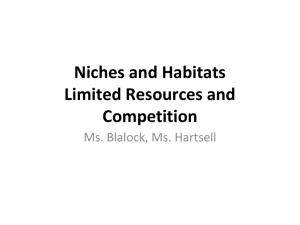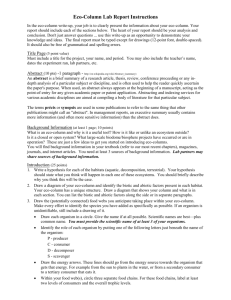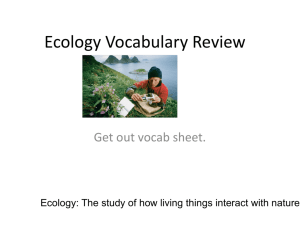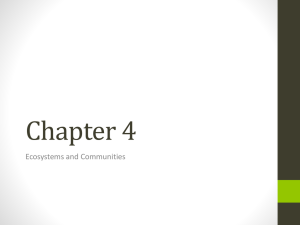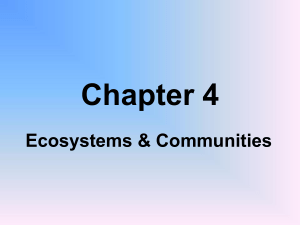Habitats, Niches, and Community Interactions
advertisement
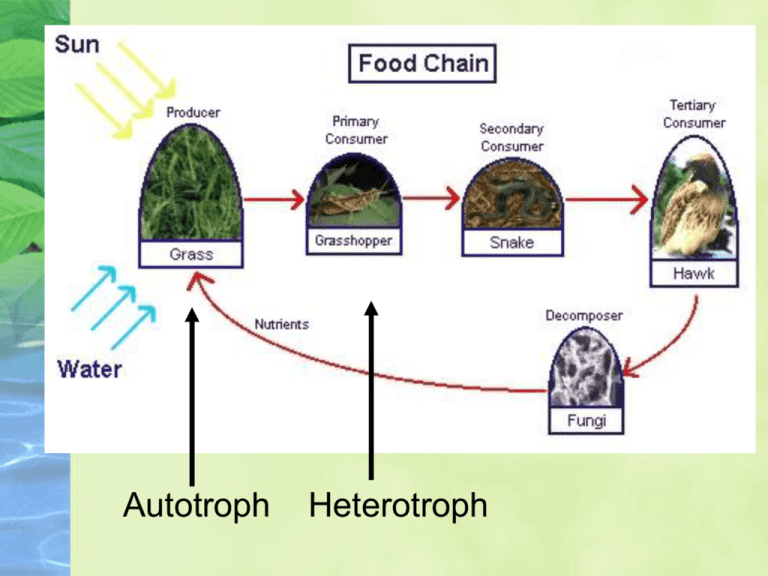
Autotroph Heterotroph Food Web Energy Flow Energy Pyramids: Habitats, Niches, and Community Interactions 4.2: Pg. 90-93 Biotic and Abiotic Factors • Ecosystems are influenced by a combination of biological and physical factors • Biotic Factors: the biological influences on organisms • Abiotic Factors: Physical, or nonliving, factors – i.e. temp, precipitation, humidity, wind, nutrient availability, soil, sunlight, etc. Habitats and Niches • Habitat: the area where an organism lives. Includes both the biotic & abiotic factors • Niche: the full range of physical & biological conditions in which an organism lives & the way in which the organism uses those conditions Niche includes… • Place in the food web • Range of temp. organism needs to survive • Type of food organism eats • How it obtains food • Who uses the organism for food • Physical conditions required to survive • When & how organism reproduces Competitive Exclusion Principle • No two species can share a niche in the same habitat!!...example is the Warblers… Warbler Niches Each of these warbler species has a different niche in its spruce tree habitat. By feeding in different areas of the tree, the birds avoid competing with one another for food. Community Interactions • Community interactions, such as competition, predation, and various forms of symbiosis can powerfully affect an ecosystem. Competition • Competition: occurs when organisms of the same or different species attempt to use a resource at the same place and time. Trees in competition for light Predation • Predation: one organism captures and feeds on another Lynx and Hare Symbiosis • Symbiosis: Any relationship in which two species live closely together – Mutualism: both species benefit Clownfish and sea anemone Hummingbird and Flower – Commensalism: one species benefits, other neither harmed nor helped Barnacles on a whale – Parasitism: one organism lives in or in another & harms it A flea or tick feeds on the blood of its host and may also carry disease-causing microorganisms Mistletoe in a tree Characteristics of Populations 5.1 pg. 119-122 Characteristics of Populations are: 1. Geographic distribution (area inhabited by population) 2. Density 3. Growth rate 4. Age structure Factors that affect population size are: 1. Number of births 2. Number of deaths 3. Number of individuals that enter or leave population • • Immigration – move in Emigration – move out • If a population has abundant space and food and is protected from predators & disease, then organisms will multiply and the population will increase. Exponential growth occurs when the individuals of a population reproduce at a constant rate. J-shaped Curve – Exponential growth Occurs under ideal conditions with unlimited resources (Has not reached its carrying capacity) S-shaped curve – Logistic Growth Populations are limited by space, food, etc. Carrying capacity – largest number of individuals that a given environment can support
